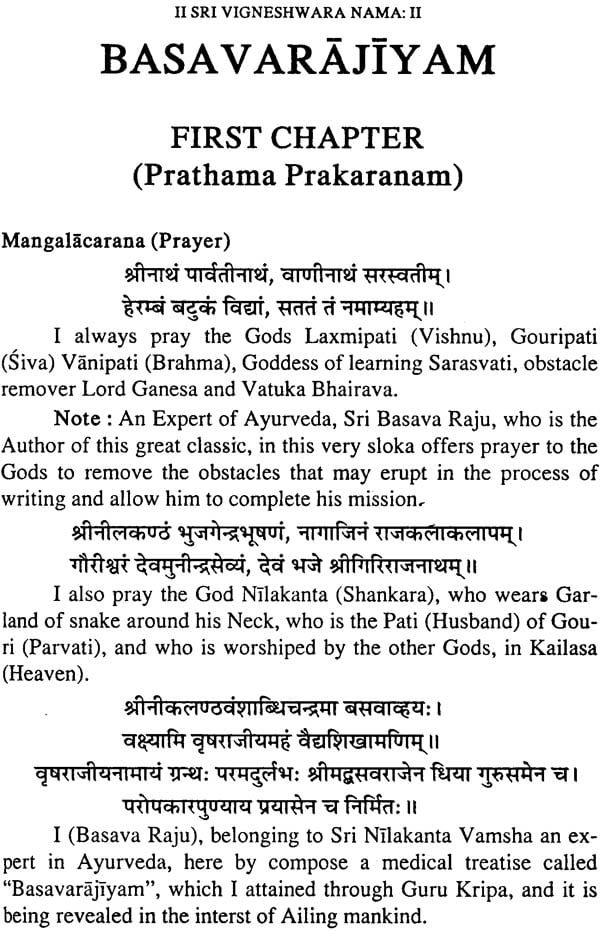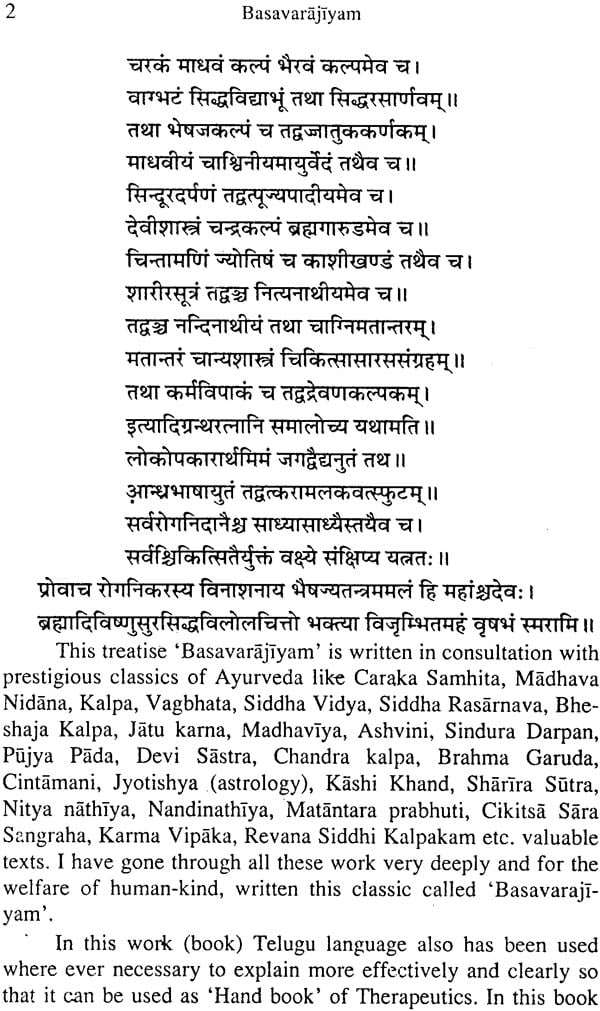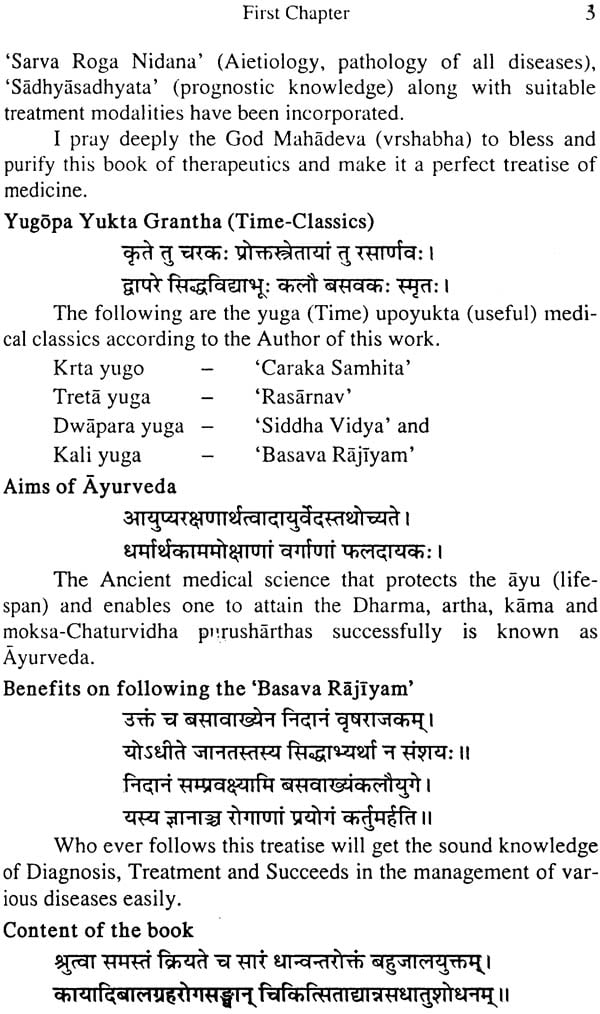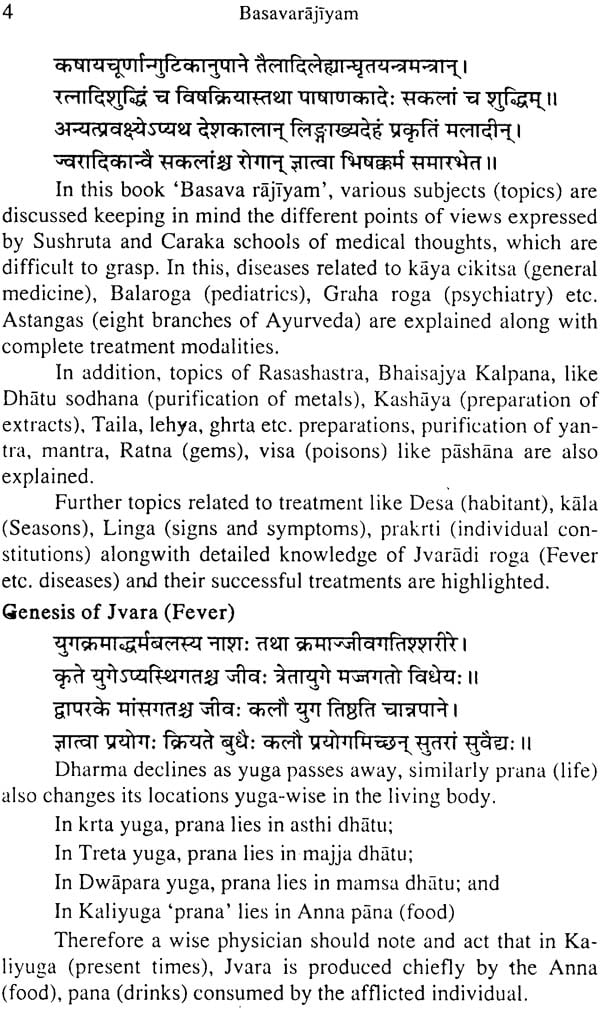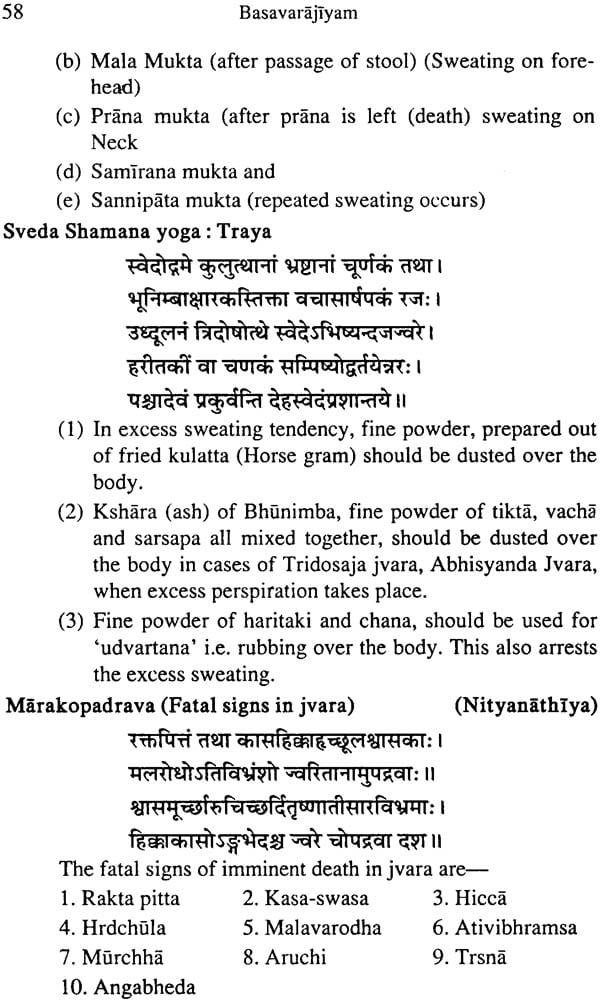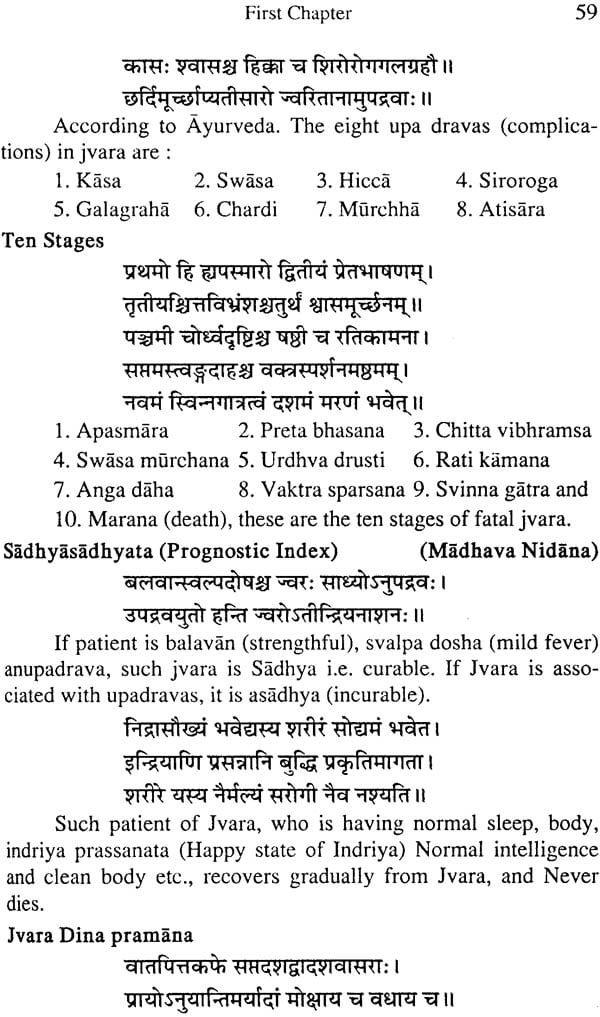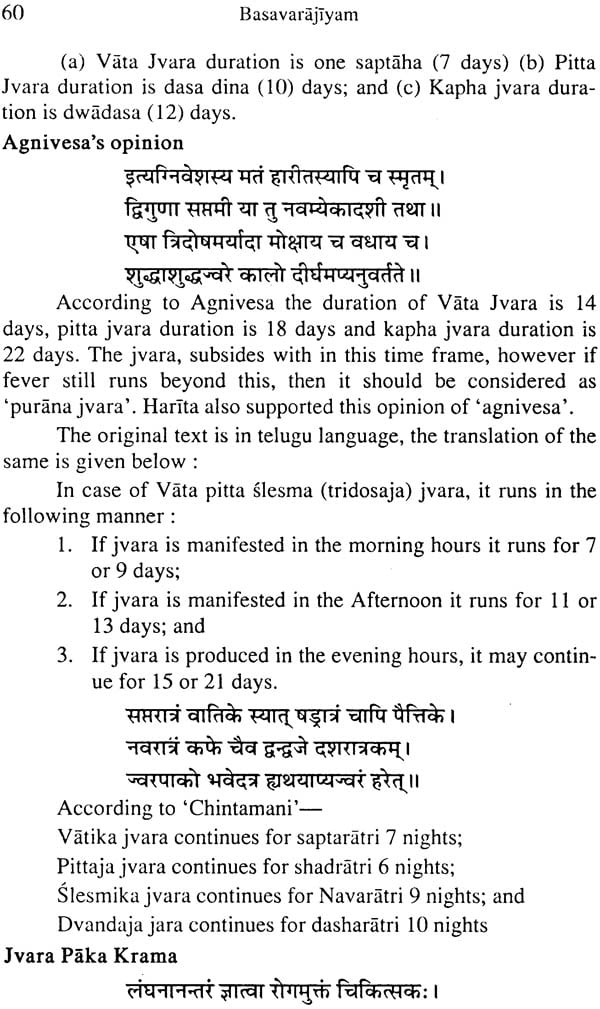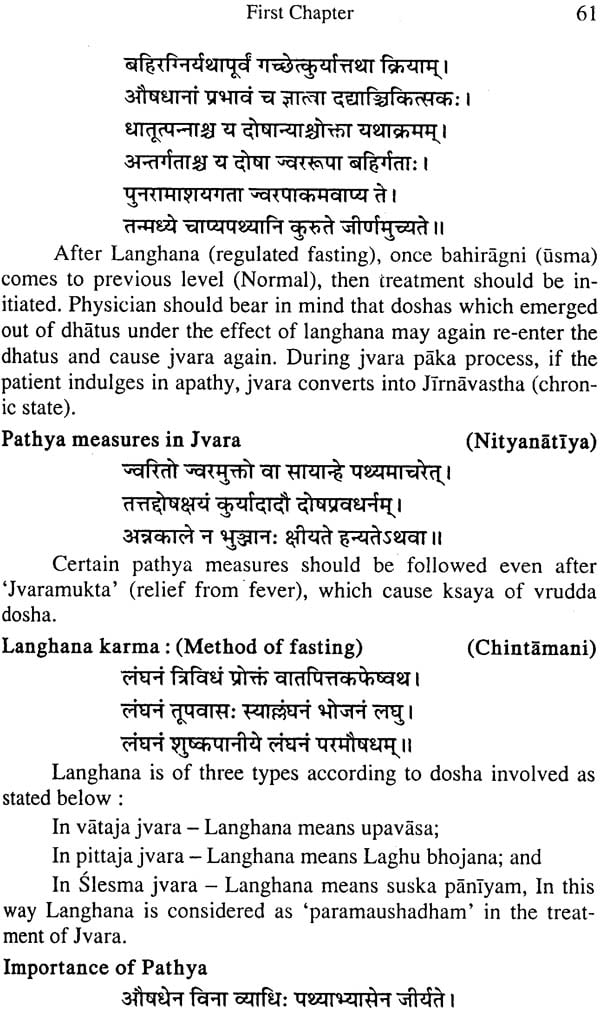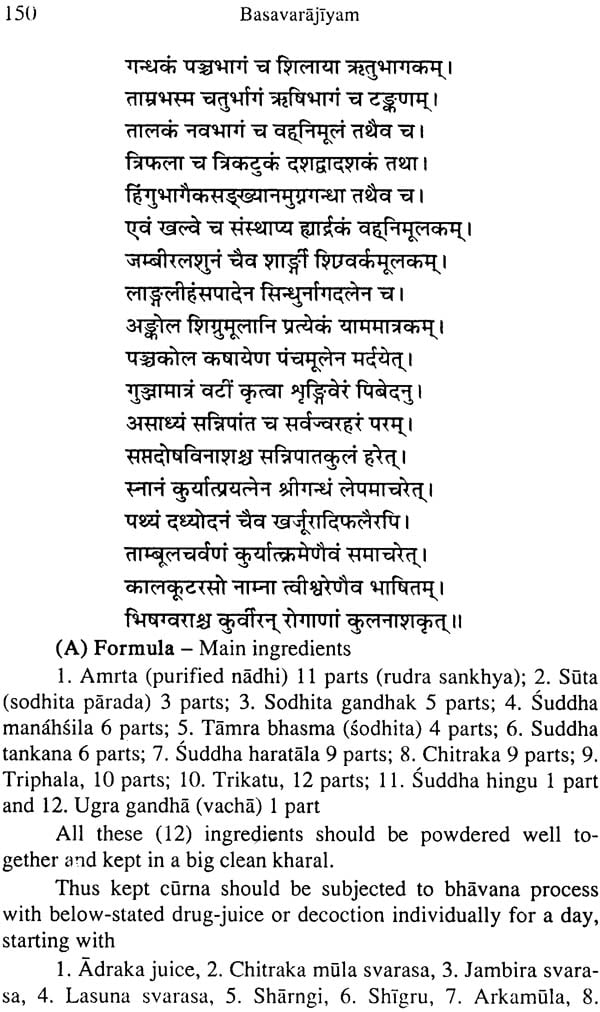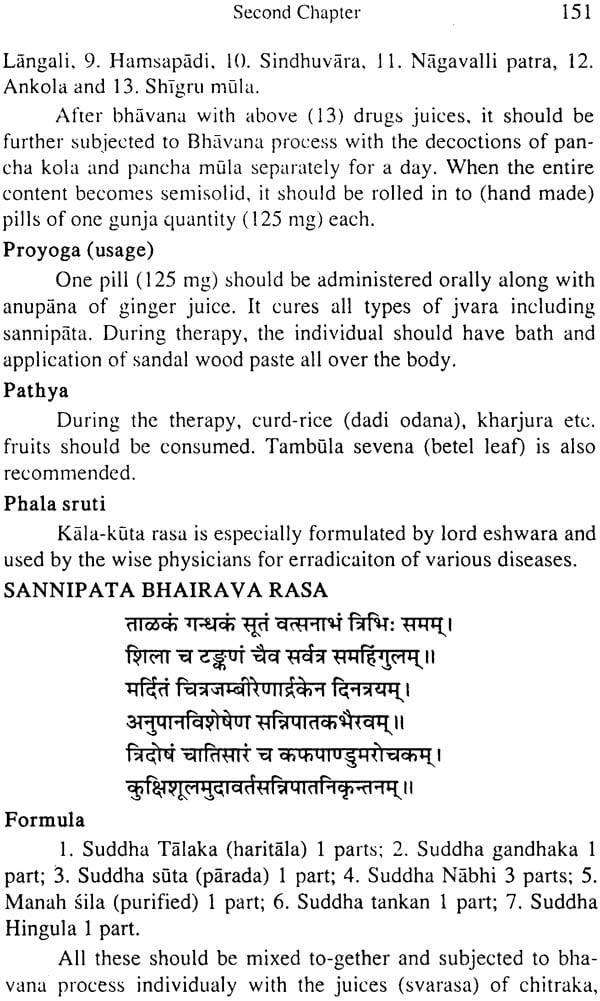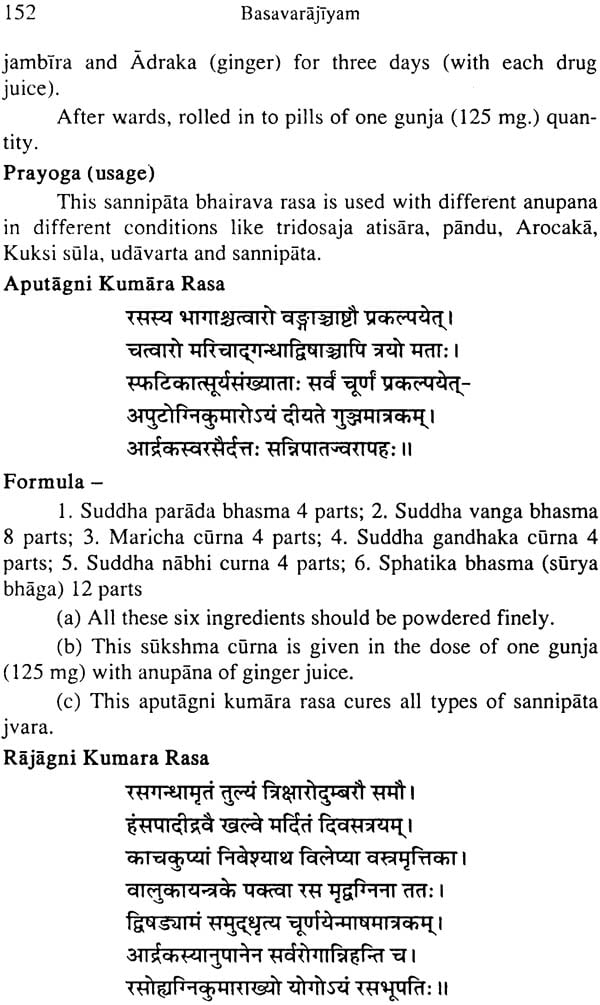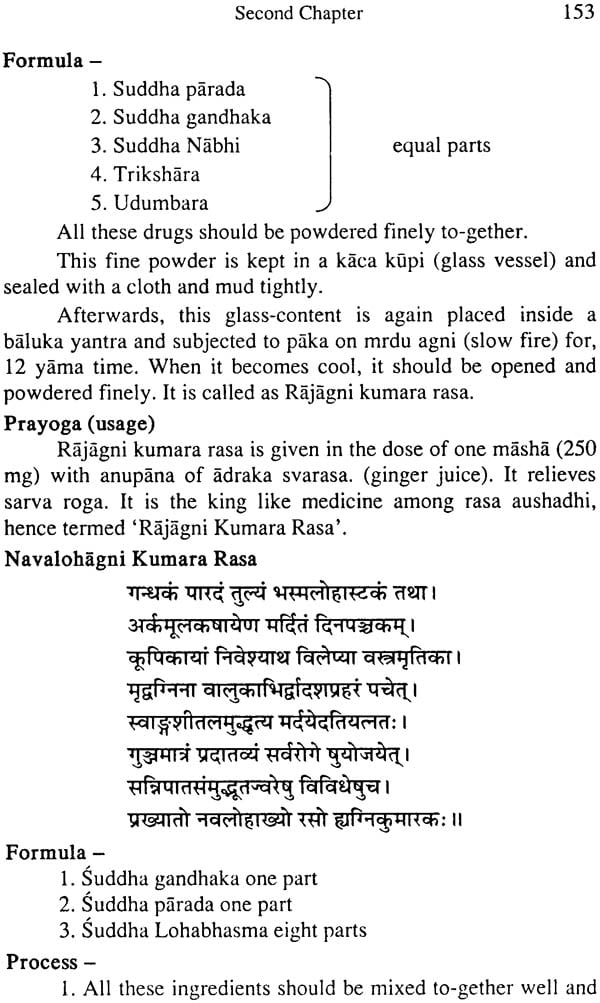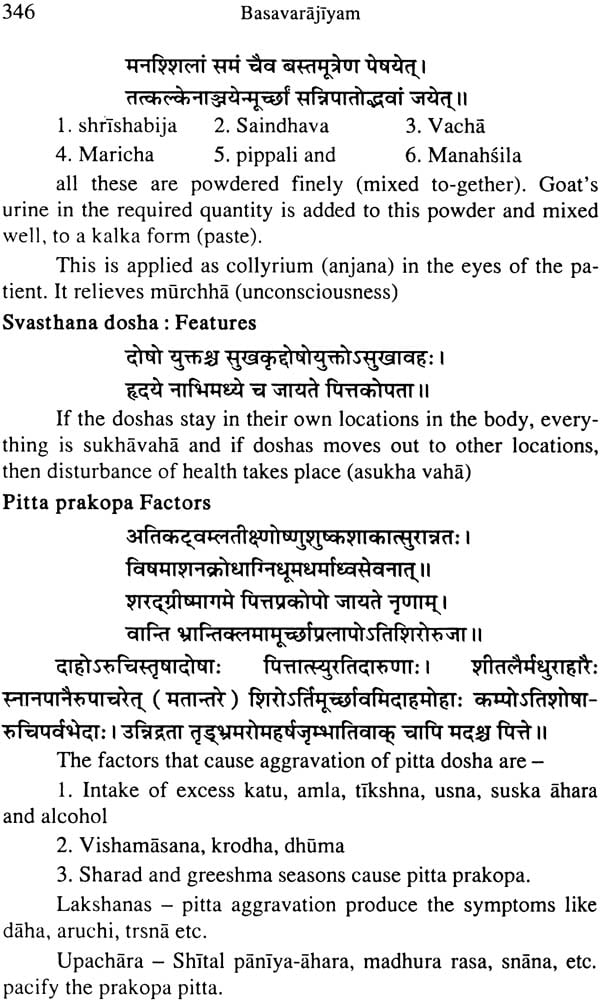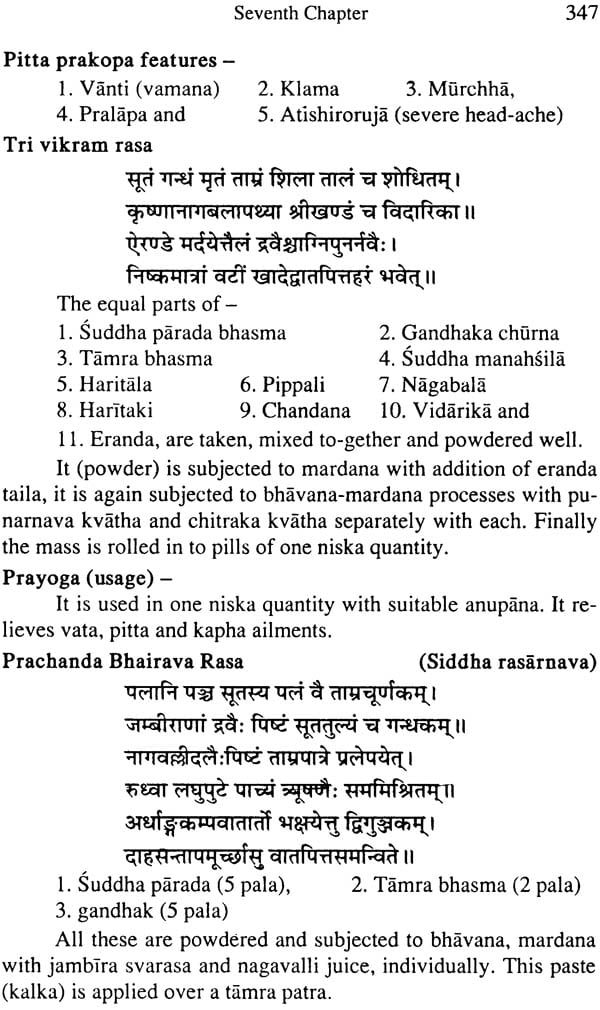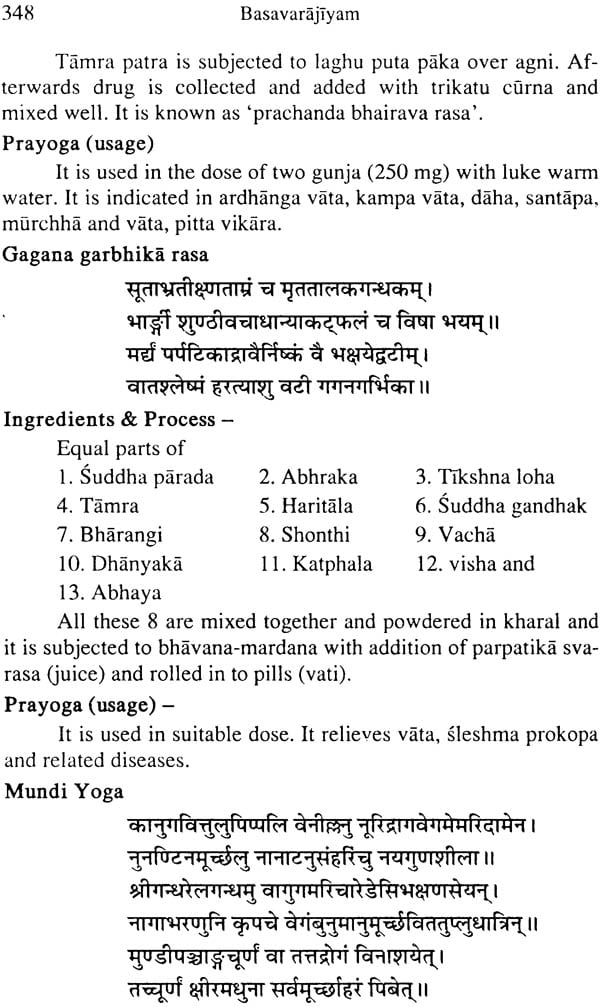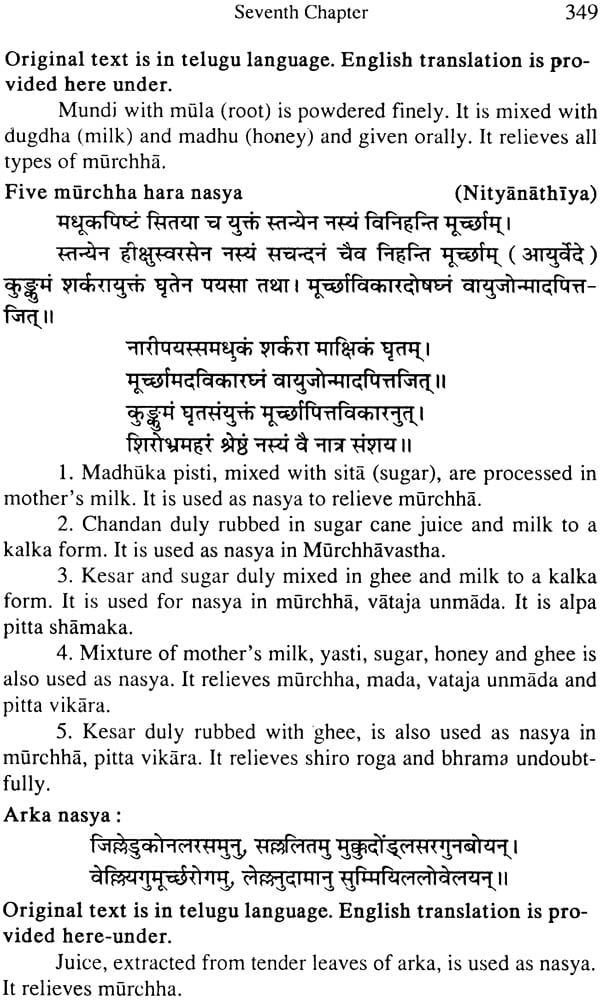
Basavarajiyam (Sanskrit Text with English Translation)
Book Specification
| Item Code: | NAJ722 |
| Author: | Prof. S.Suresh Babu |
| Publisher: | Chowkhamba Krishnadas Academy |
| Language: | Sanskrit Text with English Transaltion |
| Edition: | 2014 |
| ISBN: | 9788121803571 |
| Pages: | 368 |
| Cover: | Hardcover |
| Other Details | 9.0 inch x 6.0 inch |
| Weight | 500 gm |
Book Description
A seires of books on different facets of Ayurveda were written by the Eminent vaidyas based on their experimentations and observations, duly following the basic principles and tenets of Samhita kala Ayurveda, these works nourished and enriched the ancient medicine to evolve, expand and enlarge further.
'Sri Basava Rajiyam' is one such contribution from Andhra Pradesh, it was written is Sanskrit and partly in telugu language roughly around, 1764-1797 AD but published first time in, 1913- 1919 in Madras. Author of this treatise is 'vaidya jana bhushana'. Sri Nilakanta kottur basava Raju was an eminent practioner of Ayurveda. He belonged to 'sidda-rudra sampradaya' -Shaiva- especially 'veera shaiva' - Lingayat sect.
Sri Basava Rajiyam, covers areas like roga nidana; chikitsa with pathya and apathy; effective formulations diseare-wise; method of preparation (medicines) (Bhaisajya kalpana), rasa-shastra, shodhana of minerals, yantra vijnana etc. However it's main stress in on therapeutics. It's original contributory formulations which are so effective and so popular include- svachhanda bhai-ravai, jvarankushrasa, shitamshurasa, malini vasanta rasa, jvara murari, vaishnavi rasa, bhedi jvarankush rasa, an and a bhairavi, chintamani rasa, jayamangala rasa, mrtyunjaya rasa, tarunakra rasa, Ardha-nariswara rasa, Agni kumara rasa, sutika bharana rasa, Lokanatha rasa, Badavagni rasa, sudhanidhi rasa, paityantaka rasa Ardha khandavalehya, vasanta kusumakara, Ramabana rasa Chandra kala rasa, Lilavilasa rasa, Bilvadi Lehyam, Trivikram Rasa etc. Hundreds of formulations still rule the Ayurveda therapy.
Apart from this, Basava Rajiyam exclusively specialised Nadi pariksha, karma vipaka and daivavya prashya chikitsa.
Dealing with nadi pariksha he says "A physician who does not know the nadi vijnana fails in chikitsa like a blind person, who trys to climb the high mountain".
The important points observed by the Basava Raju are "As- ta-sthana of nadi", which are the centres of 'prana vayu'.
This indicates the oxygenated blood flowing in the arteries, which is the prime factor for survival. He recommends that by sparsa, pidana and mardana, the physician should stimulate the 'prana vayu' located inside nadi (arteries) before examining the pulse.
Further, Basava rajiyam described the nature of the pulse doshic-wise. Vata bahulya nadi has been compared with 'sarpa' - snake movement type curves, in still excessive vata predominence, the pulse resembles to that of 'stabdha tantri' - the stiff thread.
Pitta bahulya nadi is like kakavath (crow) which is chancha- la (unstable). Kapha nadi represents the gait of frog. Many such comparisions are drawn in the context of nadi pariksha.
Inview of this, an humble attempt has been made to trans- late it in to English language so that it can reach the wider section of Ayurveda students, scholars, teachers and practioners. While translating, original Sanskrit / telugu edition of 'basava-Rajiyam' and other editions are studies carefully. As a beginning, first eight chapters are presented in this first volume, with an explanatory note, wherever necessary.
| Prathama Prakaranam (First Chapter) | 1-116 |
| Mangalacarana (Prayer) | 1 |
| Self-Introduction of Author | 1 |
| About the treatise Basava Rajiyarn | 1 |
| Aims of Ayurveda | 3 |
| Content of book (Basava rajiyam) | 3 |
| Jvara: Genesis, Samprapti | 4 |
| Line of Treatment | 5 |
| Nadi: Astadhatu sthana (Locations) | 6 |
| Nadi pariksha, Methods | 7 |
| Characteristics of Vata, Pitta and Kapha Nadi | 9 |
| Sannipata Nadi, Asadya Nadi, Mrtyu Nadi, Trikala Nadi etc | 11 |
| Nadi pariksha : Restrictions | 13 |
| Importance of Nadi pariksha | 14 |
| Sparsa lakshana, Nadi sabda etc | 14 |
| Jvara: Features | 15 |
| Jvara in different animals | 16 |
| Ahika jvara features | 17 |
| Shita jvara features | 18 |
| Pashu patastra rasa for shlta jvara | 18 |
| Maha Pashu patastra rasa for shita jvara | 19 |
| Dyahika jvara features, Triratra jvara | 19 |
| Pratapa Martanda Rasa, Jvarankusa | 20 |
| Triratra jvara chikitsa | 23 |
| Chaturtika jvara, Features and treatment | 23 |
| Masurika Jvara | 25 |
| Sphotaka Jvara - Treatment | 26 |
| Krimi roga, Treatment | 27 |
| Jantu jvara and it's treatment | 29 |
| Jvaratisara, Treatment of R. Atisara | 30 |
| Jvaramukta Lakshana, Reasons for relapse of Fever, Jvara mantra, Jvara Samprapti | 31 |
| Purva rupa of Jvara | 33 |
| Vata jvara features | 34 |
| Pitta jvara - features, Sleshma jvara | 36 |
| Vata-pitta jvara, Sleshma-vata jvara | 38 |
| Sannipata jvara features | 39 |
| Daha jvara, Ajirna jvara, Bhuta jvara features | 40-41 |
| Vishama jvara, Causes, features, Types | 41-42 |
| Satata, Santata jvara krama | 43 |
| Sukra-gata jvara features - treatment | 45 |
| Ama jvara features | 46 |
| Nirama jvara features, Tvak gatadi jvara | 47 |
| Rakta, mamsa, astigata, kala, jvara | 48-49 |
| Agantuja jvara, Abhinyasa jvara | 51 |
| Kama jvara, Asadya jvara features | 51-52 |
| Visucika jvara, Features, Treatment | 54 |
| Kamala jvara features, Jirna jvara | 55-56 |
| Taruna, Madhyama and Purana jvara - definition | 56 |
| Balaspota jvara, features and treatment | 56 |
| Sutika jvara features | 57 |
| Svedagamana - stages, Sveda shaman yoga | 57-58 |
| Fatal signs in Jvara (Ten stages) | 58 |
| Sadya - asadyata (Prognostic - Index) | 59 |
| Jvara duration and Jvara paka | 60 |
| Imp. of pathya in Jvara | 61 |
| Purana jvara treatment | 63 |
| Different yoga (Formulations) indicated in different types of jvaras (also see special appendix) | 63-115 |
| Dvitiya Prakaranam (Second Chapter) | 116 |
| Sannipata utpatti karana, Causes, Features | 116 |
| Prognostic Index of Sannipata jvara | 120 |
| Features of different Sannipata jvara | 121-139 |
| Seven Types' of complications | 140 |
| Sannipata Jvara - yoga | 151 |
| Tritiya Prakaranam (Third Chapter) | 169 |
| Mana-kaya-dosha attributes | 169 |
| Locations of dosha | 169 |
| Vikara of vata, pitta and kapha | 171 |
| 3 types of Examination two types of Medicine, Season-wise dosha condition | 172 |
| Dvividha upakrama | 173 |
| Mutra pariksha method | 174 |
| Urine characteristics (disease-wise) | 176 |
| Caturtha Prakaranam (Fourth Chapter) | 179 |
| Kshaya roga Nidana | 179 |
| Clinical features of kshaya | 181 |
| Chaturvidha kshaya features | 184 |
| Ekadasha rupa | 185 |
| Kshaya upadrava | 186 |
| Svara bheda roga | 187 |
| Kshaya roga Aushadhi (See special-drugs list) | 188 |
| Pancam Prakaranam (Fifth Chapter) | 200 |
| Pandu roga Nidana, Purva rupa etc | 200 |
| Pandu roga features | 201 |
| Line of treatment | 204 |
| Halimaka - features, treatment | 211 |
| Pathya and Apathya in Pandu | 217 |
| Shotha: Nidan, features etc | 218 |
| Shotha - complications | 222 |
| Shotha-hara yoga (Formulations) | 222 |
| Kamala: Nidana, features etc | 225 |
| Kamala hara yoga (drugs) | 226 |
| Sastha Prakaranam (Sixth Chapter) | 229 |
| Ashiti vata roga (80 types of vataroga) | 229 |
| Vataroga: Nidana and chikitsa | 231 |
| Saptam Prakaranam (Seventh Chapter) | 297 |
| 24 types of Pitta roga, features and treatment | 297 |
| Rakta-pitta, features | 318 |
| Treatment | 321 |
| Amla pitta: features | 326 |
| Chikitsa | 328 |
| Chardi: Nidan, features etc | 334 |
| Treatment | 336 |
| Murccha: Nidana etc | 342 |
| Difference between Murccha, bhrama, tandra and nidra | 345 |
| Tandra: Features | 345 |
| Treatment | 347 |
